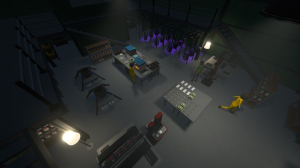Immersive Initiation I embarked on my journey with the Schedule I Game with a mixture of curiosity and a readiness to immerse myself in an entirely novel experience. From the moment I loaded the game, I was greeted by an interface that promised depth, complexity, and an ever-evolving narrative. My initial encounter felt like stepping into a worl...
Best Games Like Schedule I



Immersive Strategy and Narrative: A Journey Through the World of Schedule I
Immersive Initiation
I embarked on my journey with the Schedule I Game with a mixture of curiosity and a readiness to immerse myself in an entirely novel experience. From the moment I loaded the game, I was greeted by an interface that promised depth, complexity, and an ever-evolving narrative. My initial encounter felt like stepping into a world that was born out of both creativity and technical ambition. The designers of Schedule I had clearly taken caution to craft something that defies expectations, and I was eager to explore every nuance.
The opening screens and menus hinted at the multifaceted journey ahead, and every detail of the interface was meticulously designed. I found myself adjusting settings and tinkering with options that were clearly intended to tailor the experience to individual tastes. This initial phase set the tone for what would be a rich tapestry of innovation and engagement, making me feel both in control and wonderfully challenged. The elegance of the entry point assured me that I was in for an adventure that would test my reflexes and intellect alike.
A New Realm of Strategy
Stepping into the tactical landscape of Schedule I, I was immediately struck by the intricate framework of strategies embedded in its core gameplay. Unlike many games that rely solely on brute force or repetitive tasks, this game introduced unique decision-making points that required foresight. I found myself analyzing every move, weighing choices that would alter the terrain of my experience. Each option seemed carefully calibrated to enhance both risk and reward, ensuring that every action brought about a significant impact on the unfolding narrative.
The strategic depth was multifaceted; it wasn’t just about planning the next move but also about understanding the subtleties of my environment. I appreciated the layers of complexity woven into the system, where every choice had a ripple effect. I spent hours dissecting even the smallest elements of the gameplay, understanding that every detail mattered in a world built on smart, reactive mechanics. The game constantly beckoned me to challenge my assumptions, revealing hidden layers with every strategic step I took.
Engaging Gameplay Mechanics
As I delved deeper into Schedule I, I was thoroughly impressed by the tactile responsiveness of its gameplay mechanics. Navigation through the virtual environments felt both intuitive and responsive, creating a harmony between my actions and the game’s reactions. I particularly enjoyed the way the game integrated my input, making every command, gesture, and decision an intrinsic part of the immersive experience. This seamless interaction elevated my connection with the game, transforming routine gameplay into a highly engaging adventure.
The mechanics were not static; they evolved as I progressed, offering fresh challenges and rewarding innovation. I observed a clever balance between automated features and player control, ensuring I never felt overwhelmed by complexity. Instead, I found a comfortable blend where my personal tactics meshed with the game’s dynamic responses. The system rewarded creativity and determination, making each accomplishment feel uniquely earned. This dedication to a well-crafted control scheme really enhanced my sense of involvement and satisfaction.
Dynamic Narrative Approach
One of the standout features of Schedule I for me was its dynamic narrative. The storyline unfolds like an intricate tapestry, where every thread interweaves to create a broader picture. I was not merely spectators to a pre-written plot; instead, I shaped the direction of the narrative through my own choices. This narrative freedom transformed every session into a personal saga, with the game reacting to my unique style of play.
The dialogue and character interactions were carefully crafted, giving me insight into a world that was both vibrant and unpredictable. I felt emotionally invested as I navigated through personal challenges and unforeseen twists. The characters were complex, evolving as I made decisions that had consequences both immediate and far-reaching. This approach made the narrative feel like a living entity—one that breathed alongside me and adapted to the myriad paths I chose to follow.
Striking Visual Aesthetics
The visual presentation of Schedule I captivated me from the start. Its artistic design was a blend of contemporary art styles and imaginative landscapes, each rendered with a meticulous attention to detail. I marveled at the vivid scenes that unfolded before my eyes, where a carefully chosen color palette and masterful lighting effects played a significant role in setting the mood. Every environment felt like an intricately painted canvas, drawing me deeper into a realm that was both familiar and fantastical.
Every setting, from bustling virtual cities to quiet, isolated enclaves, was meticulously designed to evoke specific emotions. I found that the aesthetics were not merely for show; they served a functional purpose in guiding me through the game world. Subtle visual cues hinted at hidden pathways and secrets, making exploration both productive and visually rewarding. The artistry of Schedule I truly resonated with me, as each detail contributed to an immersive tapestry that proudly displayed the game’s distinct sensibility.
Cinematic Audio Experience
Complementing the visual splendor was the game’s outstanding audio landscape. The soundtrack was an orchestration of ambient scores and reactive beats that shifted with the intensity of gameplay. I found myself lost in the harmony of sounds that seamlessly mingled with the gameplay, elevating each moment to a cinematic level. The audio engineering was clearly a priority, as every note and sound effect was intricately synced with the game’s events.
The strategic placement of sound cues heightened my situational awareness, often alerting me to changes in the environment that might have otherwise slipped by unnoticed. I experienced a range of emotions as the background scores evolved from calming, reflective tunes to pulsating, suspenseful rhythms—each perfectly timed with the unfolding drama. The attention to detail in the auditory realm made each game session feel like an immersive performance, drawing me further into this well-crafted universe.
Interactive Puzzle Integration
Schedule I impressed me with its integration of thought-provoking puzzles that interlaced with the main gameplay. As I traversed the game’s various challenges, I encountered moments that required a mixture of logic, creativity, and observational skills. These puzzles were seamlessly incorporated into the storyline, making them feel like organic challenges rather than isolated tasks. I found that each puzzle added an element of surprise and satisfaction, as solving one often unlocked rewards and narrative progression that enriched the overall experience.
The design of these challenges was both intricate and rewarding. I took pleasure in the clever use of environment-based puzzles, where every object or feature could be a clue hinting at a larger mystery within the game. The balance between straightforward and cryptic puzzles kept me engaged, as I continually looked forward to what new intellectual challenges might lie ahead. Schedule I’s puzzles were a testament to the game designers’ foresight, ensuring that my mental engagement was as important as my reflexive actions.
Gameplay Depth and Complexity
The layered structure of the gameplay in Schedule I added a significant level of depth that kept me engrossed for hours on end. I found that the experience was designed in a way that encouraged exploration into both the overt and subtle elements of the mechanics. Each layer of complexity provided rewards that were both immediate and far-reaching. It was evident that the game was built on a foundation of iterative design—each new challenge supported by previous encounters, offering me a rich world to gradually understand and master.
This multi-tiered approach not only boosted the sense of accomplishment when I overcame hurdles, but also fostered an intense desire to unearth hidden elements extended throughout the game. I discovered that there were nuances in the mechanics that could only be appreciated by diving into the details. Whether it was the interplay between different elements or the way multiple systems interlocked to produce a coherent gameplay experience, every discovery reinforced my belief in the game’s commitment to complexity and depth.
Intuitive Controls and Functionality
The control system of Schedule I was a revelation in itself, blending traditional inputs with innovative additions that made every action intuitive. I particularly appreciated the responsiveness that the game offered, as every movement and command invoked a palpable connection to the virtual environment. The system was clearly engineered to recognize nuanced user inputs, translating them into sophisticated in-game actions that felt both natural and gratifying.
In my sessions, I spent a considerable amount of time experimenting with the control schemes, noting that there was a high level of customization available. This allowed me to tailor the gameplay experience according to my preferences, ensuring that the interface felt less like an obstacle and more like a natural extension of my will. The functionality was streamlined in such a way that it reduced the learning curve, making intricate maneuvers both accessible and challenging as I evolved in my role.
Strenuous Challenges and Exploration
The game did not shy away from presenting me with challenges that were both physically and mentally demanding. Each level brought with it puzzles, strategic dilemmas, and skill-based challenges that demanded a high level of concentration and active problem-solving. I often found these moments to be the core of my enjoyment, as the adrenaline of facing and overcoming obstacles instilled a sense of real accomplishment. The game constantly nudged me out of my comfort zone, encouraging me to adopt new approaches and strategies as I moved forward.
Exploration played a significant role in the overall experience. Wandering through diverse environments, I made surprising discoveries and uncovered story fragments that enriched my understanding of the world. There were side paths and hidden zones that rewarded curiosity, creating an ecosystem of rewards that was both engaging and expansive. I relished the intricate balance between caution and daring, as every new territory held the promise of unfathomable secrets. The pathway was fraught with enough challenges to keep me on my toes, yet it always offered a sense of wonder that made each exploration feel uniquely personal and thrilling.
Personal Reflection in the Virtual World
Throughout my journey in Schedule I, I was continually drawn into an introspective dialogue with the setting and its characters. In weaving my own experiences into the elaborate narrative, I discovered that the game not only entertained me but also invited profound self-reflection. There were moments when I felt as though the game was mirroring my own struggles and triumphs, presenting me with scenarios that resonated on a personal level. This unexpected emotional depth transformed the experience into more than mere gameplay, evolving it into a platform for self-discovery.
The reflective quality of the virtual world was enhanced by subtle narrative cues and vivid character portrayals. I encountered scenarios that made me pause and think about my personal values and decisions. Every challenge and interaction felt like an opportunity to better understand the interplay between choice and consequence. As I navigated through layered subplots and complex character dynamics, I began to see the virtual space as a canvas on which I could project my own ideas and emotions, leading to moments of genuine introspection.
Expanding Horizons: The Relevance of Schedule I
While I immersed myself in the daily adventures of Schedule I, I also took time to appreciate the game’s broader implications. Its design was not only aimed at providing a seamless experience but also at expanding the conceptual boundaries of interactive media. I greatly enjoyed the way the game subtly challenged conventional norms and encouraged a reconsideration of what video games can aspire to be. The integration of creative narrative techniques, layered strategy, and innovative mechanics culminated in a product that pushed beyond the traditional limitations of its genre.
This expansive outlook was reflected in every aspect of the game—from the modular design of its levels to the interplay of various gameplay elements that demanded attention and care. I observed that even the most subtle moments in the game had been designed with a larger vision in mind, one that sought to redefine the boundaries of interactive storytelling. The comprehensive experience shaped my perception of digital entertainment, convincing me that every detail, no matter how minute, contributes to the overall potency and relevance of the medium.
- Multi-layered strategic gameplay that rewards thoughtful decision-making
- Responsive gameplay with intuitive controls enhancing player experience
- Stunning visual aesthetics that create a captivating environment
- Cinematic audio that elevates the overall atmosphere
- Seamless integration of puzzles and exploration that adds depth
- Immersive narrative that deeply engages the player
- Intricate puzzles can sometimes interrupt the flow of the game
- Extensive customization options might cause confusion for some users
- Strategic complexity may overwhelm new or casual players







